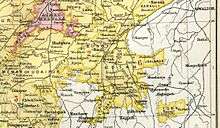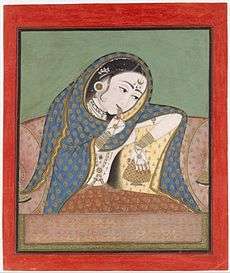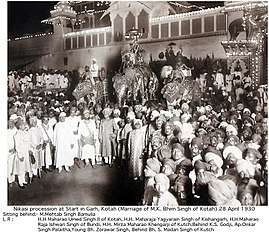Kota State
Kota State, also known as Kotah State,[1] was a state in India, centered on the city of Kota, now located in Rajasthan State of the India.
| Kota State Kotah State | |||||||
|---|---|---|---|---|---|---|---|
| Princely State of British India | |||||||
| 1631–1949 | |||||||
 Flag
 Coat of arms
| |||||||
 Kota State in the Imperial Gazetteer of India | |||||||
| Area | |||||||
• 1931 | 14,828 km2 (5,725 sq mi) | ||||||
| Population | |||||||
• 1931 | 685,804 | ||||||
| History | |||||||
• Established | 1631 | ||||||
• Independence of India | 1949 | ||||||
| |||||||
| Today part of | Rajasthan, India | ||||||
The town of Kota was once the part of the erstwhile kingdom of Bundi. It became a separate princely state in the 17th century. The state belonged to the Kotah-Jhalawar Agency which had headquarters at Kota and was a subdivision of the Rajputana Agency.
History
_Hunting_with_Maharao_Ram_Singh_of_Bundi_(reigned_1828-1866)_LACMA_M.75.19_(2_of_9).jpg)

In 1631 Kota state seceded from Bundi State. Between 18 June 1707 and 8 September 1713 it was briefly reunited with Bundi again. On 26 December 1817 Kota state became a British protectorate who were granted a hereditary salute of 17 guns by the British.
The average revenue of Kota state in 1901 was Rs.31,00,000. [2]

Rulers
The rulers of Kota were from the Hada sept of the Chauhan Rajput clan and bore the title of Maharao.[3][4]
Maharaos
- Apr 1696 – 18 June 1707: Ram Singh I: (b. 16.. – d. 1707)
- 18 Jun 1707 – 8 September 1713: interregnum
- 8 September 1713 – 19 June 1720: Bhim Singh I: (b. 1682 – d. 1720)
- 19 Jun 1720 – Oct 1723: Arjun Singh: (d. 1723)
- Oct 1723 – 1 August 1756: Durjan Sal: (d. 1756)
- 1756 – Mar 1757: Ajit Singh: (b. bf. 1676 – d. 1757)
- Mar 1757 – 17 December 1764: Chhatar Sal Singh I: (b. bf.1718 – d. 1764)
- 17 Dec 1764 – 17 January 1771: Guman Singh: (b. 1724 – d. 1771)
- 17 Jan 1771 – 19 November 1819: Umaid Singh I: (b. 1761 – d. 1819)
- 19 Nov 1819 – 20 July 1828: Kishor Singh II: (b. c. 1781 – d. 1828)
- 20 Jul 1828 – 27 March 1866: Ram Singh II: (b. 1808 – d. 1866)
- 27 Mar 1866 – 11 June 1889: Chhatar Sal Singh II: (b. 1837 – d. 1889)
- 11 Jun 1889 – 27 December 1940: Umed Singh II: (b. 1873 – d. 1940) (from 23 May 1900, Sir Umed Singh II)
- 11 Jun 1889 – 5 December 1896: .... – Regent
- 27 Dec 1940 – 18 April 1948: Bhim Singh II: (b. 1909 – d. 1991)
Titular Maharaos
On 18 April 1948, the Maharao merged his state with the union of India and the state thus ceased to have independent existence. The Maharao lost his ruling powers but continued to hold certain titles and privileges until 1971, when everything was withdrawn. Nevertheless, the Maharao remains the head of the erstwhile royal family and an important cultural figure in Kota. The non-ruling Maharaos are listed below:
- 27 Dec 1940 – 18 April 1948 – 21 June 1991: Bhim Singh II: (b. 1909 – d. 1991); last ruling Maharao.
- 21 June 1991 – present: Brijraj Singh
- The heir apparent is Ijyaraj Singh, only son of Maharao Brijraj Singh
See also
References
- Chisholm, Hugh, ed. (1911). . Encyclopædia Britannica. 15 (11th ed.). Cambridge University Press. p. 919.
- https://dsal.uchicago.edu/reference/gazetteer/pager.html?objectid=DS405.1.I34_V15_427.gif
- https://dsal.uchicago.edu/reference/gazetteer/pager.html?objectid=DS405.1.I34_V15_418.gif
- Indian Princely States